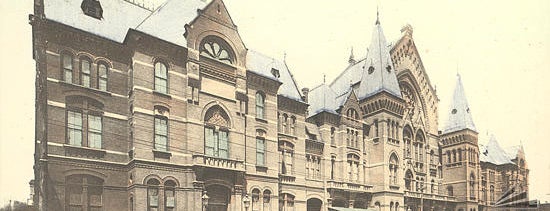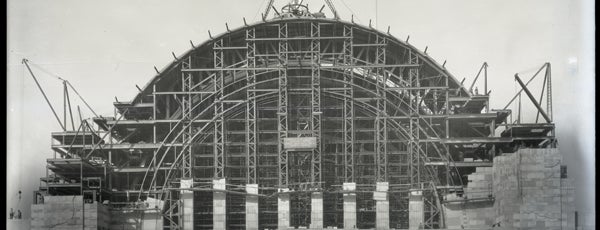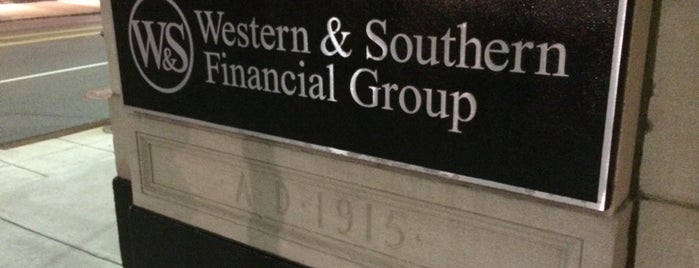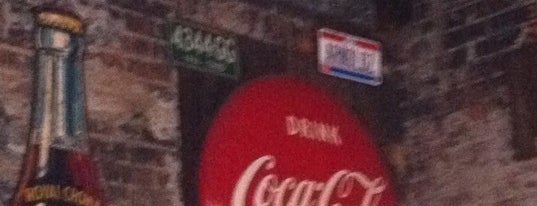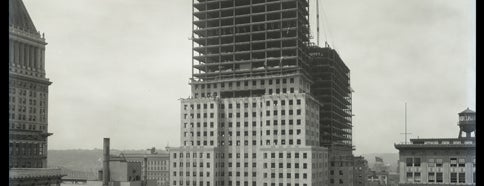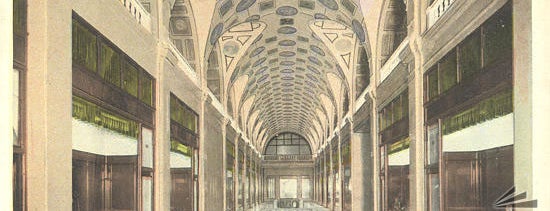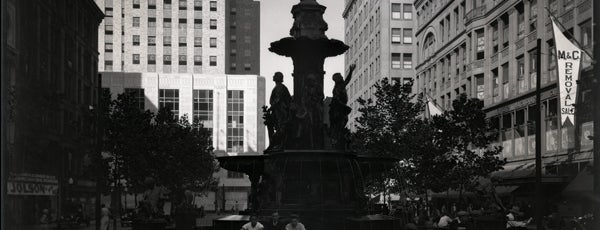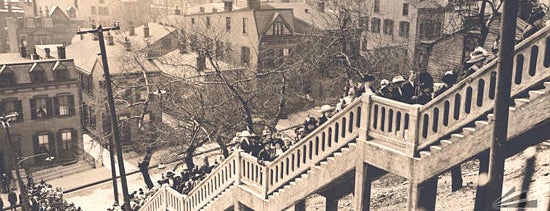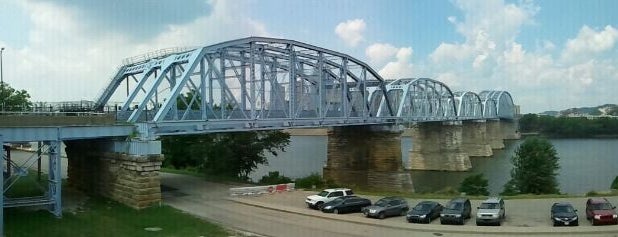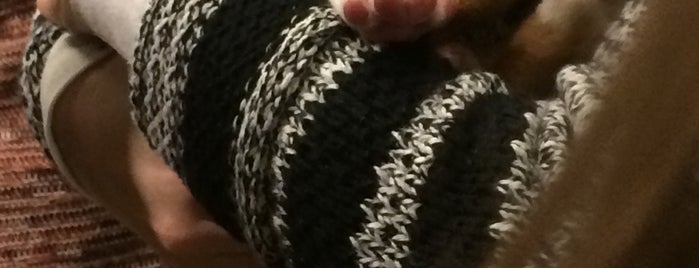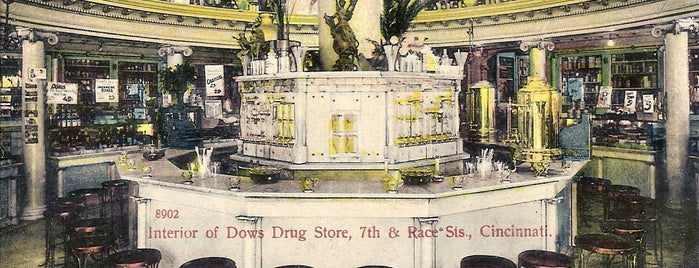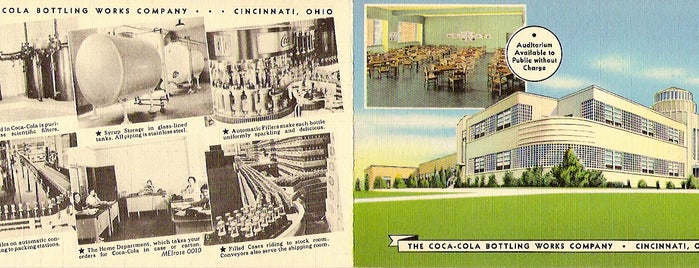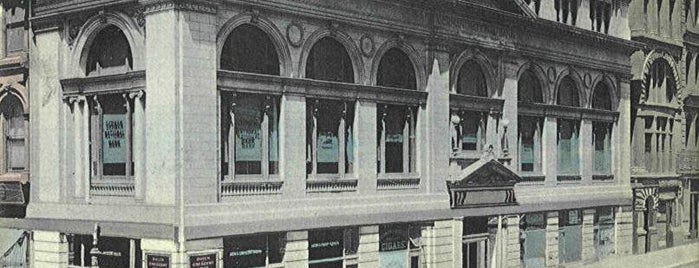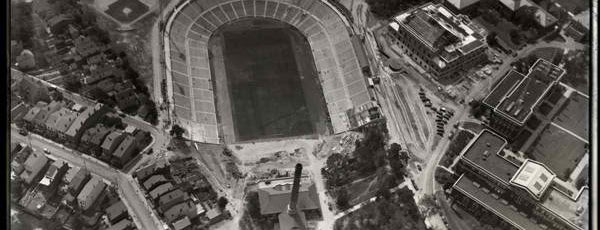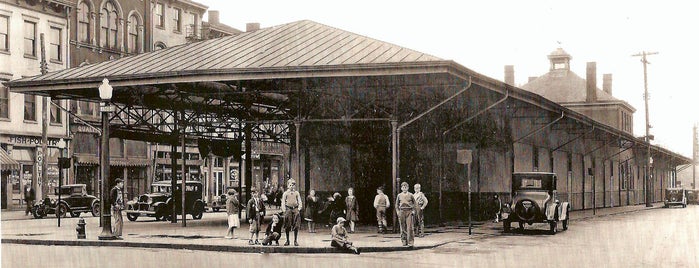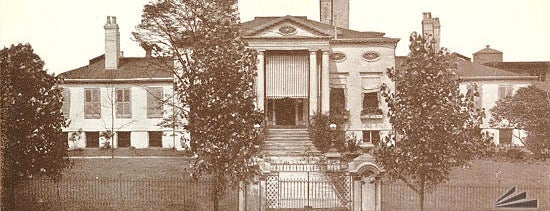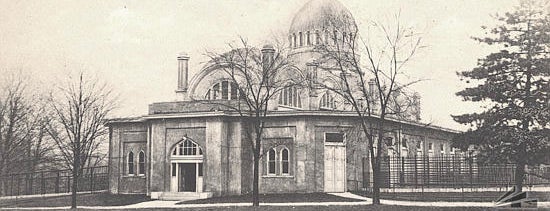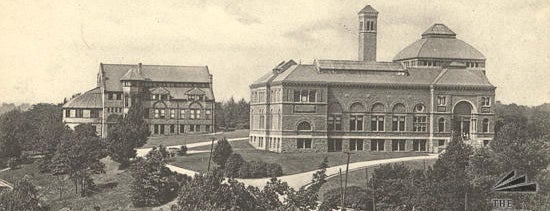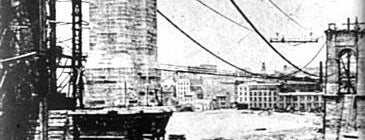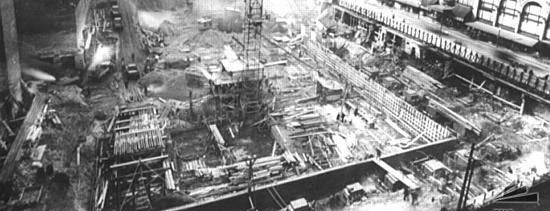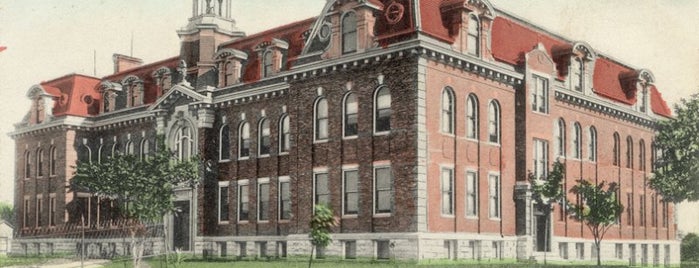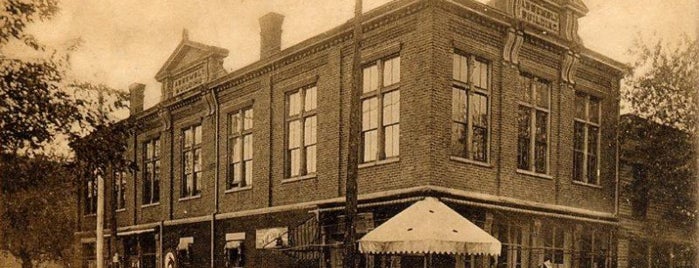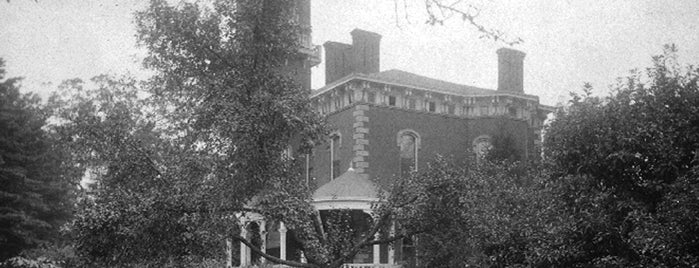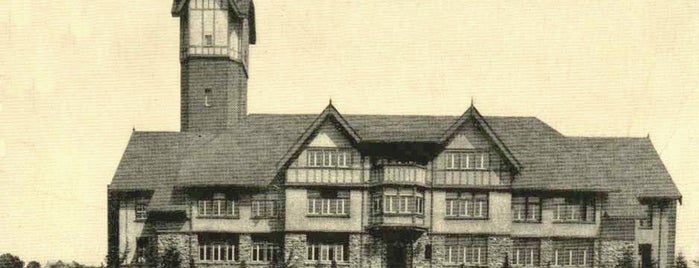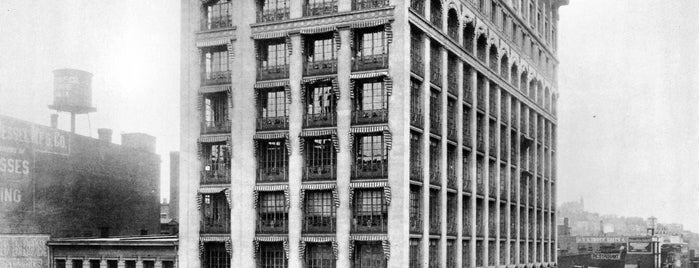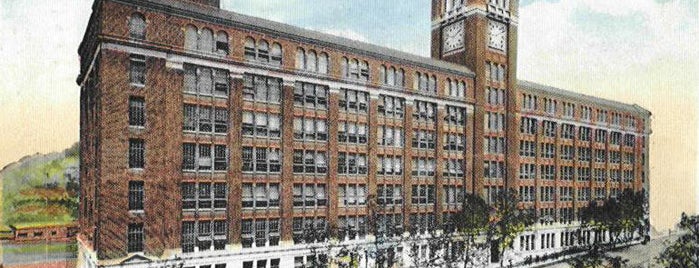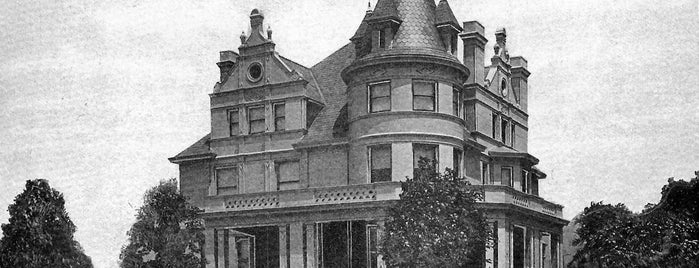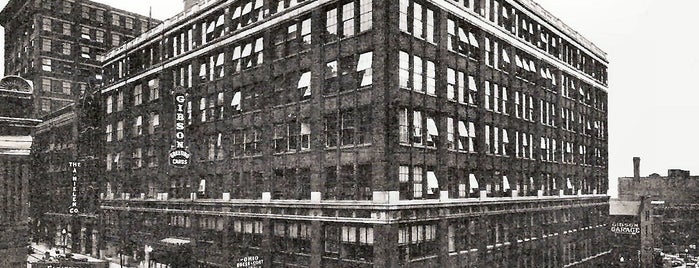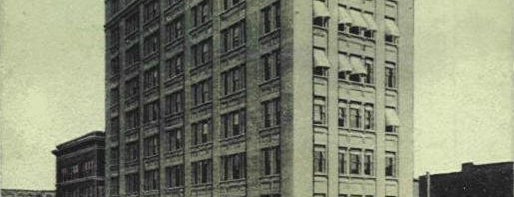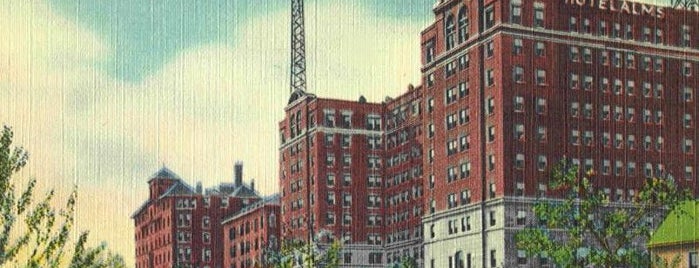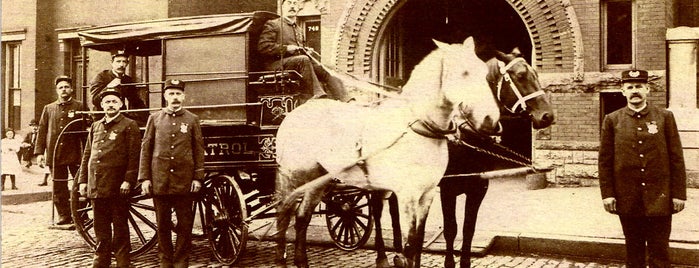![]() Ever since the 1860s, Cincinnati Catholics have been "praying the steps" of this church on Good Friday every year. This view is from 1916. Collection of Public Library of Cincinnati and Hamilton Co. Read more.
Ever since the 1860s, Cincinnati Catholics have been "praying the steps" of this church on Good Friday every year. This view is from 1916. Collection of Public Library of Cincinnati and Hamilton Co. Read more.
![]() Dow was the first drug store in Cincinnati to add a soda fountain, along with perfume, cosmetic and tobacco departments. Others soon began to copy the format. Courtesy cincinnativiews.net. Read more.
Dow was the first drug store in Cincinnati to add a soda fountain, along with perfume, cosmetic and tobacco departments. Others soon began to copy the format. Courtesy cincinnativiews.net. Read more.
![]() The building was once the Coca-Cola Bottling Plant. Their machinery processed more than 500 bottles a minute "without being touched by hand." Courtesy cincinnativiews.net. Read more.
The building was once the Coca-Cola Bottling Plant. Their machinery processed more than 500 bottles a minute "without being touched by hand." Courtesy cincinnativiews.net. Read more.
![]() City Hall has been on this site since 1852. The current building, designed by Samuel Hannaford (who designed Music Hall) opened in 1893. Collection of the Public Library of Cincinnati and Hamilton Co. Read more.
City Hall has been on this site since 1852. The current building, designed by Samuel Hannaford (who designed Music Hall) opened in 1893. Collection of the Public Library of Cincinnati and Hamilton Co. Read more.
![]() Findlay Market as it looked in 1921. Completed in 1855, it was the first iron market building in the US. The bell came from Pearl St Market when it was torn down in 1934. Courtesy cincinnativiews.net. Read more.
Findlay Market as it looked in 1921. Completed in 1855, it was the first iron market building in the US. The bell came from Pearl St Market when it was torn down in 1934. Courtesy cincinnativiews.net. Read more.
![]() The cornerstone of this 1873 building is the same one laid by John Quincy Adams in 1843 at the original Mt Ida (later Mt Adams) location. Collection of Public Library of Cincinnati and Hamilton Co. Read more.
The cornerstone of this 1873 building is the same one laid by John Quincy Adams in 1843 at the original Mt Ida (later Mt Adams) location. Collection of Public Library of Cincinnati and Hamilton Co. Read more.
![]() The Center Building first hosted classes in 1907. Board, tuition, laundry and use of library cost $45 per quarter. Courtesy nkyviews.com. Read more.
The Center Building first hosted classes in 1907. Board, tuition, laundry and use of library cost $45 per quarter. Courtesy nkyviews.com. Read more.
![]() The Assembly Building was built in 1892 to house a drug store, residences and an assembly hall. In the years since, it's been a bank, pool hall, saloon, speakeasy, and theatre. Courtesy nkyviews.com. Read more.
The Assembly Building was built in 1892 to house a drug store, residences and an assembly hall. In the years since, it's been a bank, pool hall, saloon, speakeasy, and theatre. Courtesy nkyviews.com. Read more.
![]() The Promont House was completed in 1867. It changed hands a few times before Ohio's 43rd Governor, John Pattison, moved in in 1879. It was his home until his death (5 months into his term) in 1906. Read more.
The Promont House was completed in 1867. It changed hands a few times before Ohio's 43rd Governor, John Pattison, moved in in 1879. It was his home until his death (5 months into his term) in 1906. Read more.
![]() This building was built in 1921 to complement the Gruen building. It housed the Procter & Collier Co., an advertising and printing agency for Procter & Gamble. Courtesy cincinnativiews.net. Read more.
This building was built in 1921 to complement the Gruen building. It housed the Procter & Collier Co., an advertising and printing agency for Procter & Gamble. Courtesy cincinnativiews.net. Read more.
![]() This building was built by the Gruen Watch Company in 1917. Since their watches were based on Swiss designs, they wanted their factory to resemble a Swiss chalet. Courtesy cincinnativiews.net. Read more.
This building was built by the Gruen Watch Company in 1917. Since their watches were based on Swiss designs, they wanted their factory to resemble a Swiss chalet. Courtesy cincinnativiews.net. Read more.
![]() The Gwynne building was constructed in 1914 and named for the wife of Cornelius Vanderbilt II, Alice Gwynne Vanderbilt. It served as the headquarters for P&G from 1935 to 1956. Read more.
The Gwynne building was constructed in 1914 and named for the wife of Cornelius Vanderbilt II, Alice Gwynne Vanderbilt. It served as the headquarters for P&G from 1935 to 1956. Read more.
![]() The Baldwin Piano Company once called this building home. They began as piano dealers (at 4th & Elm) in 1862, but started making their own pianos on this site in 1890. Read more.
The Baldwin Piano Company once called this building home. They began as piano dealers (at 4th & Elm) in 1862, but started making their own pianos on this site in 1890. Read more.
![]() This was the home of George "Boss" Cox, who ran Cincinnati's political machine from 1891 to 1916. A Republican, Cox's ability to deliver election results extended his power throughout Ohio. Read more.
This was the home of George "Boss" Cox, who ran Cincinnati's political machine from 1891 to 1916. A Republican, Cox's ability to deliver election results extended his power throughout Ohio. Read more.
![]() This building was originally home to Gibson Greetings. It grew to become the third largest greeting card manufacturer in the country until it was purchased by American Greetings in 2000. Read more.
This building was originally home to Gibson Greetings. It grew to become the third largest greeting card manufacturer in the country until it was purchased by American Greetings in 2000. Read more.
![]() The Second National Bank, who completed this building in 1908, had at least two presidents arrested for misappropriating bank funds, including one embroiled in the Boss Cox scandals. Read more.
The Second National Bank, who completed this building in 1908, had at least two presidents arrested for misappropriating bank funds, including one embroiled in the Boss Cox scandals. Read more.
![]() This building was originally a 1925 addition to the Hotel Alms, which was owned by Frederick Alms (of the Alms & Doepke Department Store). WKRC Radio broadcast from the hotel in their early days. Read more.
This building was originally a 1925 addition to the Hotel Alms, which was owned by Frederick Alms (of the Alms & Doepke Department Store). WKRC Radio broadcast from the hotel in their early days. Read more.
![]() On the Southwest corner of the building, you'll find old Police Patrol Station No. 4. Built in 1890, it closed after a 1955 police redistricting and the building was absorbed into the Hostess plant. Read more.
On the Southwest corner of the building, you'll find old Police Patrol Station No. 4. Built in 1890, it closed after a 1955 police redistricting and the building was absorbed into the Hostess plant. Read more.

